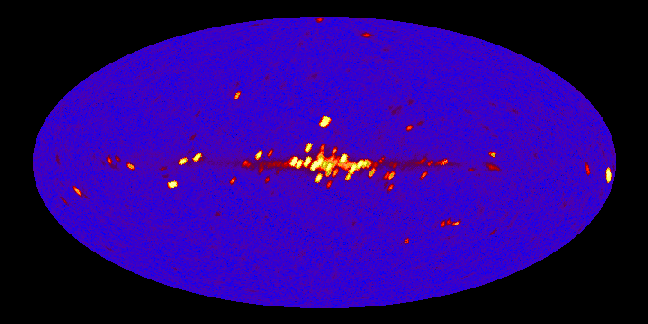Credit & Copyright: NASA,
HEAO-1,
Boldt (GSFC) and
Garmire (Cal Tech/PSU),
Skyview,
Allen,
Jahoda, Whitlock
Explanation:
What if you could see
X-rays?
If you could, the
night sky would be a strange and unfamiliar place.
X-rays are about 1,000 times more energetic
than visible light photons and are produced in violent and high
temperature astrophysical environments. Instead of the familiar
steady stars, the sky would seem to be filled with
exotic binary star systems
composed of white dwarfs,
neutron stars, and
black holes, along with
flare stars, X-ray bursters,
pulsars,
supernova remnants and
active galaxies.
This X-ray image of the entire sky was constructed with
Skyview,
using data from the first
High Energy Astronomy Observatory (HEAO 1),
and plotted in a coordinate system centered on the galactic center
with the north galactic pole at the top.
Sources near the galactic center are seen to dominate in this
false color map which shows regions of highest X-ray intensity in yellow.
Astronomers' ability to observe the sky at X-ray energies
will be greatly enhanced by the recently launched
X-ray Timing Explorer (XTE) satellite.
1999 2000 2001 2002 2003 2004 2005 2006 2007 2008 2009 2010 2011 2012 2013 2014 2015 2016 2017 2018 2019 2020 2021 2022 2023 2024 2025 |
Январь Февраль Март Апрель Май Июнь Июль Август Сентябрь Октябрь Ноябрь Декабрь |
NASA Web Site Statements, Warnings, and Disclaimers
NASA Official: Jay Norris. Specific rights apply.
A service of: LHEA at NASA / GSFC
& Michigan Tech. U.
|
Публикации с ключевыми словами:
Рентгеновский телескоп - рентгеновское излучение - рентгеновские двойные
Публикации со словами: Рентгеновский телескоп - рентгеновское излучение - рентгеновские двойные | |
См. также:
Все публикации на ту же тему >> | |
